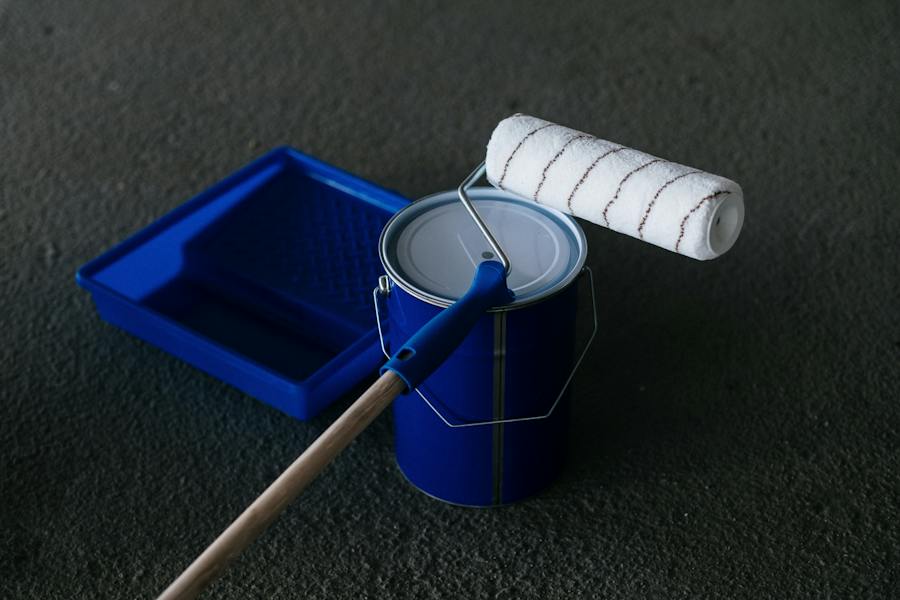How To Open A 5-Gallon Paint Bucket: A Step-By-Step Guide
Share
Opening a 5-gallon paint bucket may seem straightforward, but more complex. Correctly accessing the contents of these large containers requires the right tools, techniques, and a focus on safety. Whether you’re a seasoned DIY enthusiast or a novice painter, this comprehensive guide will walk you through the step-by-step process of opening a 5-gallon paint bucket, ensuring you can confidently tackle your painting projects while keeping safety in mind. Let’s dive in and learn how to open these sizable paint containers efficiently and without a mess.
How To Open A 5-Gallon Paint Bucket?
To open a 5-gallon paint bucket, follow these steps:
Gather Your Supplies: Before you begin, make sure you have all the necessary tools and materials. These include a 5-gallon paint bucket, a paint can opener, safety glasses, gloves, and some rags or paper towels. These items will help you stay safe and effectively manage spills or splatters.
Prepare Your Work Area: Choose a suitable work environment. Pick a well-ventilated and well-lit area, such as a garage or outdoor space. Lay down a drop cloth or plastic sheet on the floor to catch accidental spills or drips. Place the 5-gallon paint bucket on a stable and flat surface. This setup ensures you have a clean and organized workspace.
Inspect The Bucket: Take a moment to scrutinize the paint bucket. Examine the lid for any visible damage, such as dents or cracks. A damaged lid can make the opening process more challenging and may lead to problems with resealing. Also, check that the lid is tightly sealed to prevent any leakage during storage.
Safety First: Safety should be a top priority when opening any paint container. Put on safety glasses to protect your eyes from splatters or accidental spills. Wearing gloves will keep your hands clean and provide a barrier between your skin and potentially harmful chemicals in the paint.
Use The Right Tool: Different paint can openers, including traditional handheld openers and more advanced options, are available. Choose the one that suits your preference. To open the bucket, insert the paint can opener under the lid’s edge. Apply gentle pressure to lift the lid. Be patient and avoid excessive force, which can damage the lid or cause spills. If the lid is particularly stubborn, you may need to use more leverage but proceed cautiously.
Reseal For Storage: Once you’ve accessed the paint, it’s essential to reseal the bucket properly to preserve the paint’s quality for future use. Ensure the lid is securely in place. Some additional tips for resealing include using plastic wrap to create an extra seal or gently tapping the lid with a rubber mallet to ensure it’s tightly closed. Finally, store the paint in a temperature-controlled environment to prolong its shelf life.
List Of Necessary Tools And Materials
Here is a list of necessary tools and materials you will need to open a 5-gallon paint bucket:
- 5-Gallon Paint Bucket:
This is the primary container for your paint. It’s typically a large, heavy-duty plastic or metal bucket designed to store and transport considerable paint. Having the correct size container for your project is essential, as smaller tools may not be suitable for handling large quantities of paint.
- Paint Can Opener:
A paint can opener is a specialized tool designed to safely and efficiently open paint cans. It usually has a flat, pointed end for prying open the lid and a hook for removing the inner seal. Using the right tool makes the process much easier and reduces the risk of damaging the lid or injuring yourself.
- Safety Glasses:
Safety glasses are a crucial safety precaution when working with paint cans. They protect your eyes from splatters, drips, or stray paint particles released when opening the bucket. Safety glasses should be worn throughout the process to prevent eye injuries.
- Gloves:
Wearing gloves is essential to keep your hands clean and protected while opening the paint bucket. Paint can be messy and may contain chemicals that can irritate the skin. Gloves provide a barrier between your skin and the paint, reducing the risk of skin irritation or exposure to potentially harmful substances. Additionally, they can protect your hands from any sharp edges or metal parts on the lid.
- Rags Or Paper Towels:
Supplying rags or paper towels on hand is helpful for several reasons. You can use them to wipe off any excess paint that may accumulate on the lid or the rim of the paint bucket during the opening process. This helps keep your work area clean and prevents paint from dripping onto the floor or other surfaces. Additionally, you can use the rags or paper towels to clean your hands and tools after the paint bucket is open.
Safety Precautions To Open 5-Gallon Paint Bucket
Safety precautions are paramount when opening a 5-gallon paint bucket to ensure your well-being and prevent accidents. Here’s a more detailed explanation of the safety measures to take:
Wear Safety Glasses:
Safety glasses are a fundamental safety measure when working with paint containers. They shield your eyes from potential hazards, such as paint splatters, drips, or particles that can become airborne during paint opening. Ensure you choose safety glasses that are ANSI-approved and provide full eye coverage, including the sides.
Put On Gloves:
Wearing gloves is a critical safety practice to protect your hands and skin. Paint can contain chemicals and solvents that may cause skin irritation or allergic reactions. Additionally, some paints may be oil-based and challenging to wash off. Wearing gloves made of nitrile or latex creates a protective barrier, preventing direct contact with the paint and making it easier to keep your hands clean. Choose gloves that fit snugly but are comfortable to work in.
Work In A Clutter-Free Environment:
A clutter-free workspace is not only essential for safety but also for efficiency. Before you begin, clear the area of any unnecessary tools, equipment, or obstacles. This organization reduces the risk of tripping, bumping into objects, or knocking over items during the paint can opening process. A tidy workspace allows you to focus on the task without distractions.
Ventilation:
Proper ventilation is crucial when working with paint, especially in enclosed spaces. Paints can release fumes and volatile organic compounds (VOCs) that may be harmful when inhaled in high concentrations. To protect your respiratory health, choose a well-ventilated area with windows or doors that can be opened to allow fresh air to circulate. This helps disperse fumes and maintains a healthier working environment.
Stability Of Work Surface:
The stability of your work surface is vital for safety. Ensure that the surface where you place the 5-gallon paint bucket is level and sturdy. A wobbly or uneven surface increases the risk of the paint bucket tipping over, potentially causing spills or accidents. Opt for a stable workbench, table, or platform that can adequately support the weight of the paint container.
Proper Body Mechanics:
Proper body mechanics are essential to prevent strain or injury while opening the paint bucket. Avoid excessive bending, twisting, or reaching, as these actions can strain your muscles and joints. Instead, use your body’s strength efficiently and engage your core muscles to provide stability while applying pressure to the paint can opener. This practice reduces the risk of overexertion or muscle strain.
Be Patient:
Patience is a crucial safety aspect when handling a 5-gallon paint bucket. Rushing through the process can lead to errors, damage to the lid, or unexpected spills. Taking your time and applying controlled force ensures a safer and more accurate paint can opening experience. If the lid is challenging to open, avoid using excessive force, which may result in accidents or lid deformation.
Secure Lid After Opening:
Once you’ve successfully opened the paint bucket, it’s essential to reseal the lid for safe storage. An inadequately sealed lid can lead to spills or premature drying of the paint. Follow the manufacturer’s instructions for resealing, and consider using additional methods such as plastic wrap or a rubber mallet to ensure a tight seal.
Dispose Of Waste Responsibly:
Responsible disposal of waste materials is crucial for environmental and safety reasons. Dispose of used rags, paper towels, and waste materials under local regulations and guidelines. Paint-related materials and containers should be appropriately disposed of to prevent environmental contamination and potential hazards.
Bottom Line
In conclusion, adhering to these comprehensive safety precautions while opening a 5-gallon paint bucket is crucial for a smooth and secure DIY painting experience. You can minimize risks and potential accidents by wearing safety glasses and gloves, maintaining a clutter-free workspace, ensuring proper ventilation, and practicing correct body mechanics. Additionally, patience and careful lid resealing are essential for safe paint handling. Lastly, responsible disposal of waste materials ensures a safer environment. Prioritizing safety at every process step is critical to a successful and hazard-free painting project.
FAQ’s
Why Is It Important To Learn How To Open A 5-Gallon Paint Bucket Properly?
Learning how to open a 5-gallon paint bucket correctly is crucial for several reasons. Firstly, it ensures you can promptly access the paint you need for your project. Secondly, proper paint bucket handling prevents potential injuries or accidents, such as cuts from sharp lid edges or spills that can lead to slip hazards. Lastly, it allows you to reseal the bucket effectively, preserving the paint’s quality for future use and saving you money in the long run.
What If The Lid Is Stuck Or Difficult To Open?
Encountering a stubborn lid on a 5-gallon paint bucket is a common challenge. If the lid is stuck, avoid using excessive force, which can damage the lid or lead to accidents. Instead, tap it gently with a rubber mallet or a wooden block to loosen it. You can also use a paint can opener with a leverage feature to apply controlled pressure. Patience is key; sometimes, a little persistence can go a long way in safely opening a stuck lid.
Can I Reuse The Opened Paint Bucket?
Yes, you can reuse a 5-gallon paint bucket after it has been opened, but it’s essential to reseal it properly to maintain the paint’s quality. Make sure the lid is tightly closed, and consider using additional methods like plastic wrap or a rubber mallet to create an extra seal. Store the paint bucket in a temperature-controlled environment to prevent it from drying out or spoiling. Adequately sealed and stored paint can be used for future projects.

















